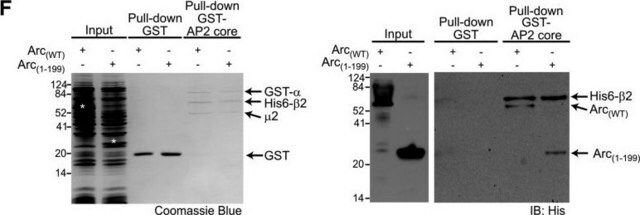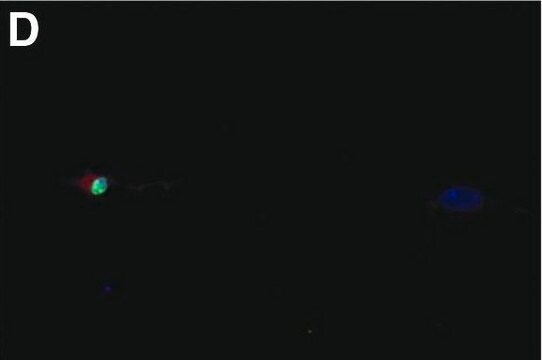T7782
Anti-Mouse IgG (Fab specific)–TRITC antibody produced in goat
affinity isolated antibody, buffered aqueous solution
Sign Into View Organizational & Contract Pricing
All Photos(2)
About This Item
Recommended Products
biological source
goat
Quality Level
conjugate
TRITC conjugate
antibody form
affinity isolated antibody
antibody product type
secondary antibodies
clone
polyclonal
form
buffered aqueous solution
storage condition
protect from light
technique(s)
direct immunofluorescence: 1:64
immunohistochemistry (formalin-fixed, paraffin-embedded sections): 1:400
storage temp.
−20°C
target post-translational modification
unmodified
Looking for similar products? Visit Product Comparison Guide
General description
Immunoglobulin G (IgG)antibody is found in four subclasses IgG1, IgG2, IgG3 and IgG4. It has a monomeric structure. IgG is secreted by B cells and is found in blood and extracellular fluids.. Anti-Mouse IgG (Fab specific) is conjugated to tetramethylrhodamine isothiocyanate (TRITC) and then purified by gel filtration to remove free TRITC.
Application
Applications in which this antibody has been used successfully, and the associated peer-reviewed papers, are given below.
Immunofluorescence (1 paper)
Immunofluorescence (1 paper)
Conjugation of TRITC to Mouse IgG (Fab specific) antibody enables the use in immunofluorescent techniques.
Biochem/physiol Actions
IgG antibody subtype provides protection from infections caused by bacteria, fungi and viruses. Maternal IgG is transferred to fetus through the placenta that is vital for immune defense of the neonate against infections.
Immunoglobulin G (IgG) antibody participates in complement fixation and opsonization.
Other Notes
Antibody adsorbed with bovine, equine and human serum proteins.
Physical form
Solution in 0.01 M phosphate buffered saline, pH 7.4, containing 15 mM sodium azide.
Preparation Note
Adsorbed to reduce background staining with bovine, horse or human samples.
Disclaimer
Unless otherwise stated in our catalog or other company documentation accompanying the product(s), our products are intended for research use only and are not to be used for any other purpose, which includes but is not limited to, unauthorized commercial uses, in vitro diagnostic uses, ex vivo or in vivo therapeutic uses or any type of consumption or application to humans or animals.
Not finding the right product?
Try our Product Selector Tool.
Storage Class Code
10 - Combustible liquids
WGK
nwg
Flash Point(F)
Not applicable
Flash Point(C)
Not applicable
Personal Protective Equipment
dust mask type N95 (US), Eyeshields, Gloves
Choose from one of the most recent versions:
Already Own This Product?
Find documentation for the products that you have recently purchased in the Document Library.
Sh Hejazi et al.
Iranian journal of parasitology, 7(3), 16-23 (2012-10-31)
Cutaneous leishmaniasis is a neglected parasitic disease, which imposes massive human distress and financial costs to the endemic countries. Better understanding of host immune response to the parasite leads to helpful strategies for disease control. Interleukin (IL)-10 and transforming growth
Sh Hejazi et al.
Iranian journal of parasitology, 7(2), 53-60 (2012-10-31)
Cutaneous leishmaniasis is a neglected parasitic disease, which imposes massive human distress and financial costs to the endemic countries. Better understanding of host immune response to the parasite leads to helpful strategies for disease control. Interleukin (IL)-10 and transforming growth
Bernhard Strauss et al.
Development (Cambridge, England), 133(19), 3883-3893 (2006-09-01)
The process of oriented divisions of polarised cells is a recurrent mechanism of cell fate diversification in development. It is commonly assumed that a specialised mechanism of spindle alignment into the axis of polarity is a prerequisite for such systems
Hua Jiang et al.
Molecular oncology, 8(2), 297-310 (2014-01-07)
Reprogramming of NK cells with a chimeric antigen receptor (CAR) proved an effective strategy to increase NK cell reactivity and recognition specificity toward tumor cells. To enhance the cytotoxicity of NK cells against CD138-positive multiple myeloma (MM) cells, we generated
M Voldstedlund et al.
APMIS : acta pathologica, microbiologica, et immunologica Scandinavica, 105(7), 537-545 (1997-07-01)
Most cells express facilitative glucose transporters. Four isoforms (GLUT1-4) transporting D-glucose across the plasma membrane show a specific tissue distribution, which is the basis for tissue-specific patterns in glucose metabolism. GLUT1 is expressed at high levels in tissue barriers such
Our team of scientists has experience in all areas of research including Life Science, Material Science, Chemical Synthesis, Chromatography, Analytical and many others.
Contact Technical Service







